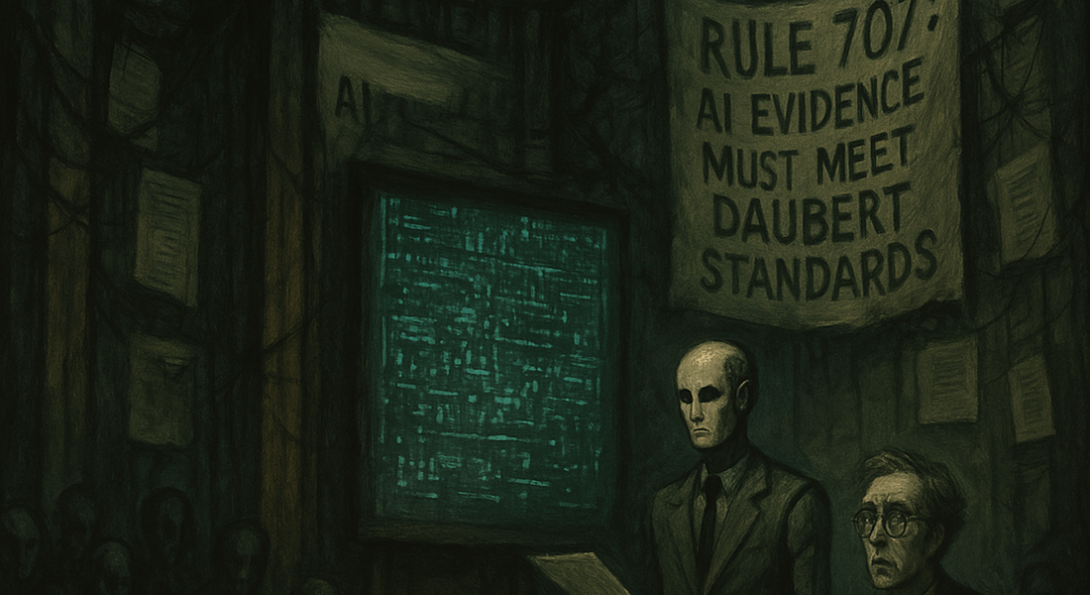Proposed New FRE 707

The Advisory Committee on Evidence Rules recommends that the proposed new Rule 707 be released for public comment.
On June 10, 2025, the Committee on Rules of Practice and Procedure ("Rules Committee")[1] reviewed the report from its Advisory Committee on Evidence Rules ("Advisory Committee"), among other things.[2] A proposed amendment to the Federal Rules of Evidence ("FRE"), including new Rule 707, would address the increasing use of AI in generating evidence for litigation.[3]
Rule 707 specifically addresses the regulation of evidence generated by machines in court proceedings.[4] The main goal is to ensure that evidence, including AI-generated data, meets the reliability standards set for expert witness testimony under Rule 702.[5] This rule applies to any evidence produced by machines or AI without the involvement of a human expert witness.[6] Importantly, evidence produced by AI must demonstrate reliability equivalent to that of human experts.[7] The intent behind this regulation is not to replace human expertise with AI but to protect the integrity of evidence when AI is utilized.[8] The proposed language for Rule 707 would be as follows:
Where machine-generated evidence is offered without an expert witness and would be subject to Rule 702 if testified to by a witness, the court must find that the evidence satisfies the requirements of Rule 702(a)-(d). This rule does not apply to the output of basic scientific instruments.[9]
Rule 707 will ensure that courts uphold strict standards for reliability, whether evidence is generated by a person or a machine.[10] AI-generated evidence acts similarly to expert testimony by offering a technical opinion on a central issue in a case. The Advisory Committee notes provided that “the intent of Rule 707 would be to address the circumstance in which machine-generated, expert-like conclusions are offered without an accompanying expert witness.”[11] For example, in a medical malpractice lawsuit, one party might present a diagnostic report from an AI system that analyzes the plaintiff's symptoms and data, concluding that the physician missed a critical diagnosis. As AI becomes further integrated into legal practice, Rule 707 will serve as a crucial safeguard.[12]
In an eight-to-one vote, the Advisory Committee recommended that the proposed new Rule 707 and its accompanying Committee Note should be released for public comment.[13] The Advisory Committee noted that the release of the proposed rule for public comment should not be construed as “a presumption that the rule should be enacted.”[14] Rather, the committee anticipated that the feedback period would yield valuable insights on the necessity of the new rule.[15] The committee expected that expert input would guide the inclusion or exclusion of machine-generated information, while public engagement was essential for informed decisions on the proposed rule.[16]
[1] The Rules Committee is an advisory body to the Judicial Conference of the United States. About the Judicial Conference of the United States, United States Courts, https://www.uscourts.gov/administration-policies/governance-judicial-conference/about-judicial-conference-united-states#organization (last visited June 26, 2025).
[2] Comm. on Rules of Prac. & Proc., Agenda Book, 5–8 (June 2025), https://www.uscourts.gov/sites/default/files/document/2025-06-standing-agenda-book.pdf [hereinafter Agenda Book].
[3] Id. at 58–59.
[4] Id. at 58.
[5] Id.
[6] Id.
[7] Id.
[8] Id.
[9] Id. at 97.
[10] Shane Ramsey, Safeguarding the Courtroom from AI-Generated Evidence: Federal Rule of Evidence 707 Approved by Judicial Conference, JDSupra (June 13, 2025), https://www.jdsupra.com/legalnews/safeguarding-the-courtroom-from-ai-1931550/.
[11] Agenda Book, supra note 2, at 94.
[12] Ramsey, supra note 12.
[13] Agenda Book, supra note 2, at 59.
[14] Id.
[15] Id.
[16] Id.